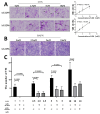Lysyl Oxidase Promotes the Formation of Vasculogenic Mimicry in Gastric Cancer through PDGF-PDGFR Pathway
- PMID: 38434983
- PMCID: PMC10905410
- DOI: 10.7150/jca.92192
Lysyl Oxidase Promotes the Formation of Vasculogenic Mimicry in Gastric Cancer through PDGF-PDGFR Pathway
Abstract
Objective: Vasculogenic mimicry (VM) generates an important supplementary form of blood supply in cancer, which many factors regulate. However, the effect of lysyl oxidase (LOX) on VM formation is unclear. In this study, gastric cancer tissues and cells were used to investigate the role of LOX in the formation of VM. Materials and Methods: The samples were collected from 49 patients with a final diagnosis of gastric cancer. According to metastasis (including lymph node metastases and distant metastases), gastric cancer samples were divided into metastasis and non-metastasis groups. Based on the degree of invasion, gastric cancer specimens were divided into T1 + T2 and T3 + T4 groups. The relative expression of LOX was detected using Western blot. The formation of VM was measured by double staining with CD34 and Periodic acid-Schiff (PAS) in gastric cancer tissue slices, and the correlation between LOX and VM was analyzed with Pearson's correlation analysis. Gastric cancer cell line BGC-803 was treated with LOX, β-aminopropionitrile (BAPN, an inhibitor of LOX), and AG1295 or AG1296 (inhibitors of the platelet-derived growth factor receptor). The formation of VM was then measured using PAS staining. The expression of platelet-derived growth factor receptor (PDGFR)α and PDGFRβ in gastric cancer cells was detected by Western blot. Results: In gastric cancer samples, the level of LOX was higher in the metastasis group than in the non-metastasis group (P < 0.05) and in the T3 + T4 group than in the T1 + T2 group (P < 0.05). VM formation was greater in the T3+T4 group than in the T1+T2 group (P < 0.05) and in the metastasis group than in the non-metastasis group (P < 0.05). The expression level of LOX was positively correlated with VM formation (P < 0.01). In gastric cancer cells, LOX concentration was positively correlated with the degree of VM, and BAPN concentration was negatively correlated with the degree of VM (P <0.05). PDGFR levels in the T3+T4 and metastasis groups were relatively higher (P <0.01) and positively correlated with LOX levels in gastric cancer specimens (P < 0.01). The relative expression of PDGFRα and PDGFRβ in gastric cancer cells was up-regulated with increasing LOX and downregulated with increasing BAPN (P < 0.05). With inhibition of PDGFRα and PDGFRβ using AG1295 or AG1296, VM formation in gastric cancer cells decreased (P <0.05), but the number of VM structures increased while LOX was added (P < 0.05). Conclusion: LOX partially promotes the formation of VM in gastric cancer through the PDGF-PDGFR signaling pathway.
Keywords: Gastric cancer; Lysyl oxidase; Platelet-derived growth factor receptor; Vasculogenic mimicry.
© The author(s).
Conflict of interest statement
Competing Interests: The authors have declared that no competing interest exists.
Figures






Similar articles
-
Emerging Paradigms in Cancer Metastasis: Ghost Mitochondria, Vasculogenic Mimicry, and Polyploid Giant Cancer Cells.Cancers (Basel). 2024 Oct 19;16(20):3539. doi: 10.3390/cancers16203539. Cancers (Basel). 2024. PMID: 39456632 Free PMC article. Review.
-
LOX inhibition downregulates MMP-2 and MMP-9 in gastric cancer tissues and cells.J Cancer. 2019 Oct 20;10(26):6481-6490. doi: 10.7150/jca.33223. eCollection 2019. J Cancer. 2019. PMID: 31777578 Free PMC article.
-
Lysyl oxidase oxidizes cell membrane proteins and enhances the chemotactic response of vascular smooth muscle cells.J Biol Chem. 2008 Aug 29;283(35):24103-17. doi: 10.1074/jbc.M709897200. Epub 2008 Jun 27. J Biol Chem. 2008. PMID: 18586678 Free PMC article.
-
[Expressions and clinical significance of vasculogenic mimicry and related protein Mig-7 and MMP-2 in gastric carcinoma].Xi Bao Yu Fen Zi Mian Yi Xue Za Zhi. 2013 Feb;29(2):194-6. Xi Bao Yu Fen Zi Mian Yi Xue Za Zhi. 2013. PMID: 23388341 Chinese.
-
LOXL2 Inhibitors and Breast Cancer Progression.Antioxidants (Basel). 2021 Feb 19;10(2):312. doi: 10.3390/antiox10020312. Antioxidants (Basel). 2021. PMID: 33669630 Free PMC article. Review.
Cited by
-
Emerging Paradigms in Cancer Metastasis: Ghost Mitochondria, Vasculogenic Mimicry, and Polyploid Giant Cancer Cells.Cancers (Basel). 2024 Oct 19;16(20):3539. doi: 10.3390/cancers16203539. Cancers (Basel). 2024. PMID: 39456632 Free PMC article. Review.
-
Establishment and Validation of Lactate Metabolism-Related Genes as a Prognostic Model for Gastric Cancer.Curr Mol Med. 2025;25(5):637-651. doi: 10.2174/0115665240290237240424054233. Curr Mol Med. 2025. PMID: 38726778
-
Roles of PDGF/PDGFR signaling in various organs.Korean J Physiol Pharmacol. 2025 Mar 1;29(2):139-155. doi: 10.4196/kjpp.24.309. Epub 2024 Oct 31. Korean J Physiol Pharmacol. 2025. PMID: 39482238 Free PMC article. Review.
References
-
- Bray F, Laversanne M, Weiderpass E, Soerjomataram I. The Ever-Increasing Importance of Cancer as a Leading Cause of Premature Death Worldwide. Cancer. 2021;127:3029–3030. - PubMed
-
- Van Cutsem E, Sagaert X, Topal B, Haustermans K, Prenen H. Gastric cancer. Lancet. 2016;388:2654–2664. - PubMed
-
- Chen W, Zheng R, Baade PD, Zhang S, Zeng H, Bray F. et al. Cancer statistics in China, 2015. CA: a cancer journal for clinicians. 2016;66:115–32. - PubMed
LinkOut - more resources
Full Text Sources
Miscellaneous

